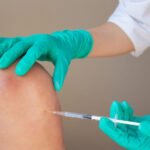
Understanding the 3 Key Injections for Knee Pain Relief
Knee pain affects millions of people worldwide, disrupting regular activities such as climbing stairs, spending time with loved ones, and even standing up from a chair. When over-the-counter medications and physical therapies don’t work, many patients explore non-invasive treatment options, including intra-articular injections. At Healwell Primary Care, we understand that each patient is unique, and our specialists provide comprehensive solutions tailored to your individual needs.
In this blog post, we’ll discuss “what are the 3 injections for knee pain?” by exploring the three most commonly used injection therapies. You’ll learn how each works, what benefits and side effects you can expect, and most importantly, how to decide which option is right for you.
Top Three Injections for Knee Pain
Over the years, research has continued on novel biological treatments. The following are the three types that remain the standard in non-surgical management of knee pain.
- Corticosteroid Injections
- Hyaluronic Acid (Gel) Injections
- Platelet‑Rich Plasma (PRP) Injections
In-Depth Analysis of Each Injection Type
1. Corticosteroid Injections
What it is
Corticosteroids are synthetic anti-inflammatory medications, such as triamcinolone and methylprednisolone, that are injected directly into the knee joint.
How it Works
By dampening the inflammatory response, these injections rapidly reduce swelling, stiffness, and pain, often within 48–72 hours.
Duration of Relief
Relief typically lasts from several weeks to a few months, making them ideal for flare-ups of osteoarthritis or injury-related inflammation.
Names of Injections for Knee Pain
Typical formulations include Kenalog, which contains triamcinolone acetonide, and Depo-Medrol, which contains methylprednisolone acetate.
Limitations
Because repeated corticosteroid shots can degrade cartilage over time, most providers, including Healwell Primary Care, limit these injections to three or four per year.
Potential Side Effects:
- Local Reactions: Pain or bruising at the injection site
- Rare Systemic Effects: Elevated blood sugar in diabetic patients, facial flushing
- Knee Injection Side Effects: Transient joint swelling or temporary flare of pain
2. Hyaluronic Acid (Gel) Injections
What it is
Hyaluronic acid is a naturally occurring component of synovial fluid that lubricates and cushions the knee joint.
How it Works
Also called “knee gel injections,” these joint pain treatments restore the joint’s shock‑absorption properties by supplementing depleted synovial fluid in osteoarthritic knees.
Duration of Relief
Most patients experience symptom improvement lasting 3–6 months, depending on the product used.
Knee Gel Injections Cost
While prices vary by region and brand, patients can expect a per‑injection range of $300–$1,000, with typical courses consisting of 3–5 weekly injections.
Potential Side Effects:
- Mild pain or swelling at the injection site
- Low risk of allergic reaction (rare with non‑animal–derived hyaluronic acid)
3. Platelet‑Rich Plasma (PRP) Injections
What it is
PRP therapy harnesses the patient’s blood platelets, concentrated through a centrifuge, to deliver growth factors that may promote tissue healing.
How it Works
When injected into the knee, these growth factors can modulate inflammation, encourage tissue regeneration, and potentially slow the progression of osteoarthritis.
What is the New Injection for Knee Pain?
PRP represents one of the most recent advances in regenerative medicine, often marketed as a cutting‑edge alternative to traditional injections.
What is the Best Injection for Knee Pain?
While “best” depends on individual response, PRP stands out for its regenerative potential and minimal risk of systemic side effects.
Duration of Relief
Variable, many patients report 6–12 months of improved function and pain relief after a single PRP session.
Potential Side Effects:
- Temporary pain and swelling at the injection site
- Very low risk of infection or bleeding, since the patient’s blood is used
| Injection type | Mechanism of action | Typical relief duration | Common side effects | Relative cost |
| Corticosteroid | Reduced inflammation | Weeks to months | Rear systemic effects, local pain | Lower |
| Hyaluronic Acid (Gel) | Supplements joint lubrication | 3-6 months | Mild swelling, injection-side discomfort | Moderate |
| Platelet‑Rich Plasma (PRP) | Delivering growth factors promoting healing | 6-12 months | Temporary pain/swelling | Higher |
Determining the Right Injection for You
The issue of knee pain depends on a wide variety of factors, including age, condition, and overall health. In this aspect, the ideal injection therapy involves several factors, including the following.
- Overall Wellbeing: Patients with diabetes may need to monitor blood sugar levels after taking steroids; those on anticoagulants should discuss the risk of bleeding.
- Type and Severity of Knee Pain: Acute inflammatory flares may respond best to corticosteroids, while chronic osteoarthritis could benefit from hyaluronic acid or PRP.
- Underlying Condition: PRP shows promise in early-stage osteoarthritis and tendon injuries, whereas gel injections excel at lubrication.
- Cost and Insurance Coverage: Corticosteroids are typically covered by most plans; however, hyaluronic acid and PRP may require an out-of-pocket payment.
- Physician Recommendation: A thorough evaluation by your certified physician ensures your treatment aligns with your unique health profile.
What to Expect Before and After Knee Injection
Before the Procedure
The specialist will review the medical history, conduct imaging, and review current medication.
During the Procedure
Under the care of our experienced specialists, your knee will be numbed with local anesthetic before the therapy is delivered via a fine needle, ensuring a comfortable and safe procedure. The whole process takes around 10-15 minutes.
After Care
- Rest the knee for 24-48 hours
- Avoid strenuous activity for 1-2 weeks
- Apply ice to reduce swelling
- Follow any physical therapy or home exercise program prescribed by your healthcare provider.
Final Thoughts
Knee injections are potent tools for non‑surgical management of osteoarthritis, injury‑related pain, and inflammatory flares. Whether you are getting the treatment from a primary care or any specialized hospital, experts tailor each treatment—corticosteroid shots, hyaluronic acid (knee gel) injections, or regenerative PRP- to your specific needs, balancing efficacy, duration of relief, and safety.
FAQ
Q. What are the 3 injections for knee pain?
A: The three most common injections are corticosteroids, hyaluronic acid gel injections, and platelet-rich plasma (PRP) therapy.
Q. What is the best injection for knee pain?
A: There is no one-size-fits-all approach; the best option depends on your specific condition, your response to treatment, and your doctor’s recommendation.
Q. How much do knee gel injections cost?
A: Knee gel injections typically cost between $300- $1,000 per injection, depending on the brand and clinic location.
Q. Are knee injection side effects common?
A: Most side effects are mild, such as local swelling or discomfort; serious complications are rare when the medication is administered correctly.
Q. Can Healwell Primary Clinic help determine the right injection for me?
A: Healwell Primary Clinic provides personalized evaluations to help select the most effective joint injection for your knee pain.
Contact Us Today
Book an in-person or online visit in seconds. Call (312) 971-7147 or click on Book Appointment.





